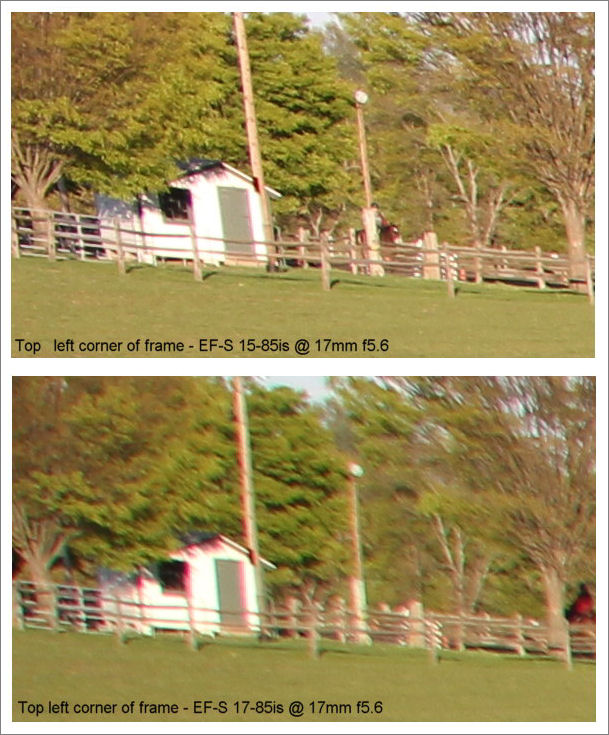

Review
Optical Performance

Canon EF-S 15-85/3.5-5.6 IS USM, 63mm f11
The most noticeable difference between the Canon EF-S 15-85/3.5-5.6IS USM and the older 17-85 IS is that the edges and corners of the image are sharper, especially at the wide end of the zoom range. The 2 additional aspheric elements and one additional UD element no doubt are responsible for this improvement.
Here are two 100% crops from the corners of the frame comparing the 15-85is to the 17-85is at 17mm

It's pretty clear that the image from the 15-85is is sharper than that of the 17-85is, plus it shows a lower level of chromatic aberration.
At the long end of the zoom range (85mm) the difference in edge quality is smaller, but the 15-85is still gives a better image.

In the center of the frame both the 15-85is and the 17-85is exhibit very similar levels of sharpness and contrast. Based on resolution chart test shots, in the center at 17mm and 50mm the two lenses were virtually identical. At 85mm the new EF-S 15-85is had a slight edge over the older EF-S 17-85is in the center of the frame (but is significantly better in the corners).

Distortion
As with the earlier 17-85is, the Canon EF-S 15-85/3.5-5.6 IS USM shows a significant amount of distortion (barrel) at the wide (15mm) end of the zoom range. Luckily this type of distortion is fairly easily corrected digitally and Canon's DPP software can even automatically correct it if you wish.

Vignetting
Vignetting is fairly well controlled, as it should be for a relatively slow lens designed for a crop sensor camera. Itís most noticeable when shooting wide open at 15mm where thereís about a 2-stop falloff in the corners of the image, reducing to about 1 stop by f5.6. At focal lengths above 20mmm thereís about a 1 stop falloff wide open.
Image Stabilization
It's difficult to quantify just how much stabilization a lens offers, but I can say that the IS system on the Canon EF-S 15-85/3.5-5.6 IS USM is very effective. Canon claim up to 4 stops and I would not dispute that claim. In unscientific testing I observed somewhere between 3 and 4 stops most of the time. Stabilization increases your odds of getting sharp images at slower shutter speeds, but doesn't guarantee it. At 85mm I found that I could handhold the lens at shutter speeds as low as 1/8s and still have a reasonable chance at sharp images. At 15mm I found that I could get sharp images much of the time with shutter speeds as low as 1/2s.
NEXT - Final Remarks and Conclusions
